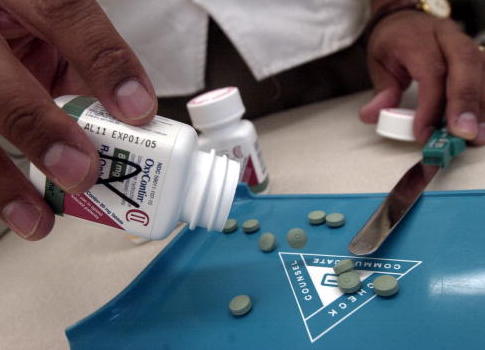Thirty-three percent of American adults have received an opioid prescription in the past two years, according to a new survey released Thursday.
Eighteen percent of American adults say that they have received opioids in the past year, and a further 14 percent have received an opioid prescription at some point in the past two years; 31 percent received one three or more years ago. Given 2016 population figures, this suggests that some 80 million Americans have received a prescription for opioids in the past two years.
For context, it is important to note that the total number of opioid prescriptions filled by Americans fell over the past year, down about nine percent. Data from the Center for Disease Control indicate that the population-adjusted number of prescriptions has fallen steadily since 2012, dropping almost 30 percent between then and 2017.
While the total number of prescriptions is falling, the new survey indicates that many Americans continue to be exposed to prescription opioids. This is alarming given still-elevated, though plateauing, rates of prescription overdose death, as well as the number of Americans admitting to abusing prescription opioids: an estimated 11.1 million last year.
The survey results come from NORC at the University of Chicago, the academic opinion research outfit responsible for the widely-respected General Social Survey. To obtain its results, NORC interviewed 1,059 people as part of its nationally representative AmeriSpeak panel.
Among those who had ever been prescribed opioids—63 percent of the population as a whole—NORC found that 91 percent filled the prescription. Twenty-nine percent of those receiving a prescription refilled it, a practice which can lead to unused pills that may in turn be diverted for misuse by others who are not the original prescribed person.
NORC also polled respondents on who prescribed them their opioids. While primary care physicians and surgeons made up the majority of opioid prescribers — 26 and 39 percent of the total, respectively — about a quarter of respondents received their opioids from their dentist or oral surgeon.
This finding is particularly alarming, as opioids may be wholly unnecessary for many dental surgeries. A meta-analysis published by the Journal of the American Dental Association in April found that non-opioid painkillers (e.g. ibuprophen and acetaminophen) were on balance preferable to opioids for dentistry-related pain.
"In order to reduce the risk of future opioid addictions, policymakers and prescribers should encourage appropriate prescribing that follows evidence-based guidelines," said Caroline Pearson, a NORC senior fellow. "Ongoing efforts to shift dental practice to non-opioid pain treatments could be one important step in continuing to stem this epidemic."
The tendency of dentists to prescribe possibly needless opioids is part of a broader laxity in prescribing which the NORC data suggest may be persisting, in spite of efforts to curb it. Historically, opioids have been a preferred method of pain management in spite of the surprisingly little research into their risks and rewards. The wave of opioid prescriptions in the 1990s relied for proof of their safety on a single letter in the New England Journal of Medicine, which was used as evidence that opioids are not habit-forming—a conclusion the wrongness of which has now been made apparent.
Indeed, there is a fair amount of emerging research indicating that non-opioid painkillers are preferable in many pain-management situations. A study published in the Journal of the American Medical Association found that opioids are on average no better than OTC medications for chronic back, hip, and knee pain treatment; another found that opioids are no better than non-opioids for treating acute pain in an emergency room setting.
All of this evidence suggests that many current opioid users would be better served with non-habit-forming, OTC alternatives. Yet, as the NORC survey makes clear, millions are still receiving prescriptions, in spite of the associated dangers.
After several years of inaction, federal lawmakers are now moving to address the broader drug overdose crisis. Congress is currently in the process of passing a package of bills targeted at supporting physicians, users, and law enforcement. And last week, the White House announced a billion dollar aid package, primarily supporting harm reduction methods. The government has also worked to reduce the supply of opioid prescriptions—the Drug Enforcement Agency announced last month plans to cut the total number of prescription pills by 169 million next year.
But it is not obvious how much of an impact these reductions are actually having. Although there are fewer opioid prescriptions, the NORC data seem to suggest, doctors are still relatively willing to prescribe opioids to their patients. A recent study of data from Michigan actually found that doctors increased, rather than decreased, the number of hydrocodone pills they handed out after the DEA cracked down on the drug in 2014. Another found that prescription drug monitoring programs—which allow doctors to track a patient's prescription history—did not meaningfully affect prescribing patterns.
Of course, many doctors are reporting that increasing distrust of opioids is driving them to prescribe the drugs less (a phenomenon decried by organizations representing chronic pain sufferers). However, it remains unclear if current pressures are enough to curb overdoses, given the apparently limited success of policy interventions and the greater efficacy of non-opioid painkillers in many (although not all) situations. If 80 million Americans are still being prescribed opioids, and 11 million are still abusing them, and 15,000 are dying from them, then a reinvestigation of our current approach may be merited.
